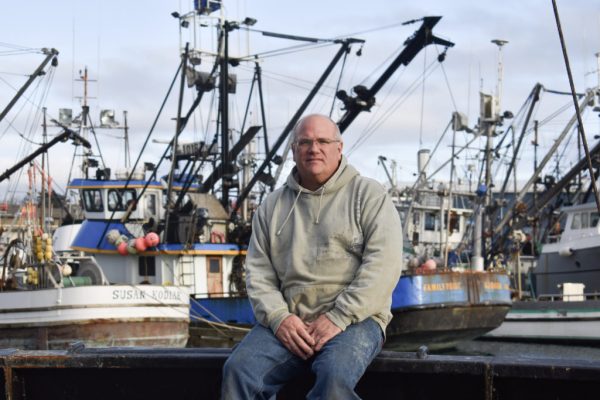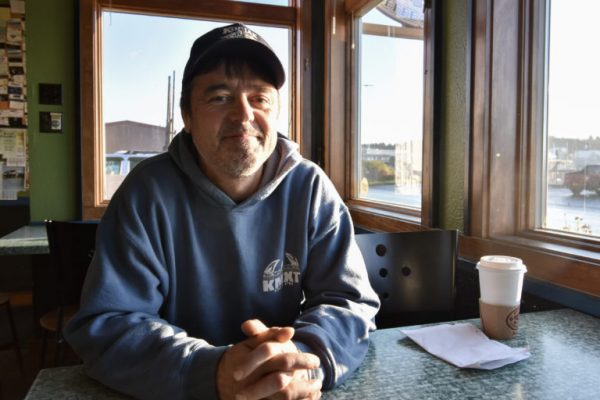
Sixty-year-old Frank Miles has fished for cod around Kodiak since he was a teenager.
“Started out at the age of 15, in an open skiff, back when salt cod was a staple,” he says. “I think I’ve missed one cod season in 44 years.”
Miles eventually graduated from an open skiff to a 58-foot pot and longline vessel called the Sumner Strait. He’s been around long enough to see fisheries cycle in and out, from the decline of king crab in the 80’s to the rise of groundfish like pollock, sablefish and of course, cod.
“If you look back just 10 years ago,” he says. “I mean, goodness, we used to fish eight months out of the year on just cod — me, personally.”
Related: Amid a big fight for cod in the Bering Sea, can small town Adak survive?
Everything changed with the emergence of a massive marine heatwave across the Pacific, commonly known as “the blob.” Between 2014 and 2016, surface ocean temperatures rose 4 to 5 degrees Fahrenheit. After that, cod started to disappear.
From the last peak in 2014, the level of mature, spawning cod crashed by more than half in the Gulf, according to stock assessment data — 113,830 metric tons in 2014 to 46,080 metric tons in 2017.
They’re now below the federal threshold that protects cod as a food source for endangered Stellar sea lions. As soon as the population dips below that line, the fishery closes. The whole federal cod fishery in the Gulf will most likely be shut down for the season in January.
The assessment about whether to close the fishery is still under review by the North Pacific Marine Fisheries Council and could be announced early next month.
Cod is a major driver of Kodiak’s winter economy, so when “the blob” subsided in 2017, fishermen hoped the fishery would bounce back.
Steve Barbeaux, a fisheries research biologist for NOAA, says cod larvae did start to show up again. But this year brought signs of a new marine heatwave, and once again, those young fish seem to be declining or disappearing altogether.
Related: There’s a new fight over Bearing Sea black cod. Warming water may be to blame
Barbeaux says the effects of each climate change-driven heat wave are delayed. Cod only enter the fishery at age three, so what we’re seeing right now is still largely due to the last blob.
“I would say we still [have] a pretty big hangover from the first heat wave. So a lot of the impact on the population was due to that first heat wave that we haven’t recovered from.” he said.
As for what’s happening with the second heat wave?
“We don’t know yet. The impact of this heat wave won’t happen for another three years when the fish enter the fishery,” he said.
And though he says cod could still bounce back with the right conditions, with a new heat wave brewing, things might get worse before they get better.
“What we’re looking at in 2019 is it just got really warm, which for the 2019 year class, that means that the eggs didn’t survive,” he says. “If it gets above a certain temperature, cod eggs don’t do well.”
One theory that gets tossed around is that cod are moving north into colder Bering Sea waters. But Barbeaux says looking at genetic studies in the region, that’s probably not the case.
“The Gulf of Alaska doesn’t really work that way. To move north, [fish] actually have to move south first. And if we look at the genetics for cod, we don’t see a lot of mixing out in the Aleutians with Gulf of Alaska cod.”
Related: Listen to THE BIG THAW: Fishermen in Kodiak cope with record low cod numbers
Barbeaux says Gulf cod would have to be drawn by food or ocean currents to move south toward the Aleutians, but “the currents don’t go that way.” On top of that, he says they haven’t seen any increase in the southeast Bering Sea cod population.
Barbeaux’s latest stock assessment found cod at less than a third of 2014 levels — 33,274 metric tons — with “next to no” new eggs. These are the lowest numbers scientists have ever documented for Gulf cod.
For many Gulf communities, the precipitous decline in catch values, and the potential for a closed fishery threaten not only fishermen, but processors and other support industries. And climate science suggests this might be the new normal.
Mike Litzow is a NOAA fisheries ecologist based in Kodiak. He and other scientists are worried about whether cod will ever bounce back in a region so affected by climate change. “We’re just well beyond what we’ve ever seen before, and it’s this very unusual, warm event,” Litzow says. “Our best understanding is that this is going to be the new average within a short time frame.”
Given how bad the last few years have been for Gulf cod, it’s difficult to find Kodiak fishermen still planning to fish the upcoming season — most have moved on to other fish, new waters, and even different lines of work.

Darius Kasprzak is a jig fisherman who used to make most of his living on cod. Sitting down for coffee on a Saturday, he explains why he was too busy for a weekday interview.
“I have to do other gigs like right now I’m working on a tugboat, I work as a skiff man on a salmon boat during the months of August and September. I have to fill in some other stuff to make a yearly livelihood now that I can’t fish cod year round.”
His last good season fishing Gulf cod was six years ago, he says, and the alternatives — switching gear types, or heading out the Bering — just aren’t for him.
Back aboard the Sumner Strait, Frank Miles knows he’s among only a handful of Kodiak fishermen still trying to make it on cod. Like Kasprzak, Miles has worked to diversify. He’s fishing Tanner crab and halibut too, but he’s hoping for cod — if not for him, then for younger fishermen.
“I’m more worried about my son and his generation, the younger guys coming up. I’m 60, you know, I’m probably just about done,” he says. “I’d like to think that I could fish cod one more time before I retire, but I don’t know. I simply don’t know where we’re going here.”
Even with the 2020 season looking so murky, Miles is going ahead with preparations, getting his boat fixed up and his pots re-webbed and ready to catch some cod.




